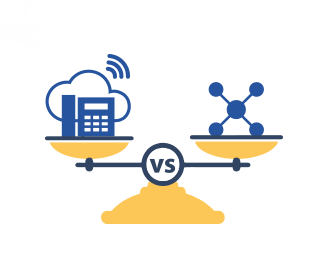What are the differences between a hosted PBX solution and a SIP Trunk?
VoIP is an acronym for Voice over IP. Voice over Internet protocol is rather popular among businesses and various other consumers right now, being a modern-day telecommunication solution. It is well-known for a good reason, as VoIP modernises communications and provides significant expense reductions. Such internet-based systems also grant various customisation station tools which old telephone service could not deliver.For many people, without a technical background, it might be challenging to make sense of everything VoIP has to offer. In this article, we will look at two similar yet different options: SIP Trunking and a Hosted PBX solution, and try to make sense of pros and cons each has to offer.
Main Distinctions
The main difference is in the deployment of the Private Branch Exchange (PBX). A hosted PBX solution is housed inside a VoIP service provider data centre premises, meaning it is a cloud-based service. Maintaining the cloud PBX usually is the responsibility of the service provider, who will be in charge of updates, bug fixes, network maintenance and more. A VoIP provider can handle all the technical aspects. Thus there are no requirements to obtain and set up additional hardware on your office premises, reducing the initial cost substantially.Managing commonly used PBX features such as call routing, voicemail, interactive voice menu, queues, etc. is no longer a problem and can be conducted from any place in the world through a web-based interface. A VoIP provider can maintain the equipment needed for you to connect all your devices, resulting in a stress-free setup, with only an internet connection required in your office to place and receive calls.
This differs from a SIP Trunking solution as this is primarily used for call termination and in a nutshell, replaces the need for telephone lines to be physically connected to your on-site PBX system. This is seen as an advantage as calls made via SIP Trunks are usually a lot cheaper than the legacy-based PSTN and ISDN line services offered.
Hosted PBX
A hosted PBX solution has a little initial cost of deployment and capital expenditure. It will remove the need from expensive maintenance contracts or internal staff required to manage the solution, which is common with the legacy-based on-site PBX deployments. Minimal on-site equipment is needed, you can use an app on a smartphone to receive and make calls, desktop handsets connected directly to your internal office network, or diversions to external numbers. A high degree of flexibility and scalability are possible with hosted PBX solution, with a considerable benefit being the support for a remote workforce without the need for sizeable interconnecting network fees to and from head offices.Various issues associated with on-site PBX deployments, which could interrupt your business processes, will no longer become an issue with a hosted PBX deployment: high licensing costs, power failures, hardware failures, line cards, office fire or flooding, power costs and more. Hosted PBX solutions are controlled via a web portal. Usually, changes can be made by users who have little technical ability, a simple drag and drop web interface is often all that is required to configure advanced and straightforward call handling flows. Some cons associated with a hosted PBX solution might be, that your service provider may not have all the features needed for your business, has a high degree of control or it might be company policy to host all systems internally if you’re within a larger organisation.
SIP Trunking
A SIP trunk is utilised for call termination of inbound and outbound calls from a PBX system usually hosted physically on business premises. This will replace the need for physical lines being required to place and receive calls. Multiple lines in SIP trunking terms are known as channels and can be increased in a matter of minutes as opposed to lines which generally require some physical changes at the business premises and exchange. One of the most significant advantages of using a SIP trunk being connected directly to an on-site PBX is increased flexibility around expanding call volumes, adding new numbers and being able to reduce your call cost, as rates assigned to SIP trunk services are significantly lower than PSTN and ISDN services. The only disadvantage of SIP trunking over solid lines connected to your on-site PBX is that it relies solely on your internet connection to run efficiently. If your internet connection is down or is experiencing issues, calls may be lost if your service provider is not able to offer failover or diversion facilities.
Looking for a reliable VoIP provider? Sign up at VoIPLine Telecom and get 14-Day free trial to try the best features of our Hosted PBX phone telephone solution.

